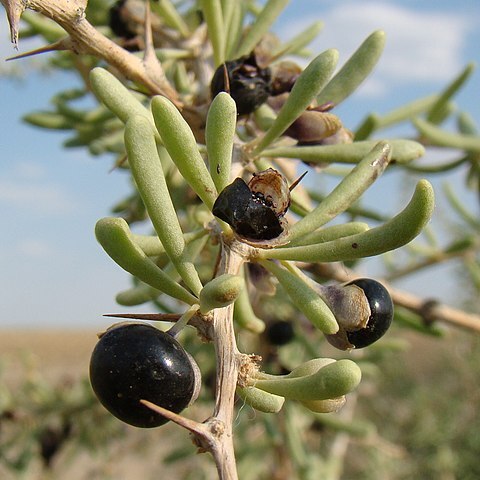Shrubs 20-50(-100) cm tall, copiously armed. Stems much branched; branches grayish or whitish, erect, ascending, or prostrate; branchlets apically thorny; thorns 3-15 mm, inserted on nodes. Leaves subsessile, solitary on young branches, in fascicles of 2-6 on short shoots in older growth; leaf blade grayish, succulent, linear or subcylindric, rarely linear-oblanceolate, 0.5-3 cm × 2-7 mm. Flowers 1 or 2 on short shoots. Pedicel 5-10 mm. Calyx narrowly campanulate, 4-5 mm, irregularly 2-4-lobed, lobes sparsely ciliate. Corolla pale purple, funnelform, ca. 1.2 cm; lobes oblong ovate, 1/3-1/2 as long as corolla tube, not ciliate. Stamens slightly exserted; filaments sparsely villous above base. Fruiting calyx slightly inflated. Berry purple-black, globose, sometimes emarginate, 6-9 mm in diam. Seeds brown, ca. 1.5 × 2 mm. Fl. May-Aug, fr. Aug-Oct.
More
A spiny shrub. It grows 1.8 m high. The shoots are greyish. The leaves are 6-25 mm long by 1-1.5 mm wide. They are narrow and can be spoon shaped. The spines are 10 mm long. The flowers occur singly in the axils of leaves. The fruit is a berry 5-8 mm wide. It is black. The seeds are kidney shaped and 2 mm long. They are brown.
Higher inner Himalayas, 1800-3900 metres. Saline deserts and sands, roadsides at elevations of 400-3,000 metres in western China.
More
In Pakistan it is a spiny shrub of dry areas between 1,500-2,600 m altitude.

